早白垩世泥炭地净初级生产力及其控制因素
——来自二连盆地吉尔嘎郎图凹陷6号煤的证据
2016-12-23闫志明邵龙义Large孙钦平
闫志明 邵龙义 王 帅 Large D J 汪 浩 孙钦平
(1.中国矿业大学(北京)地球科学与测绘工程学院,北京 100083;2.英国诺丁汉大学工程学院,NG7 2RD;3.中国石油勘探开发研究院廊坊分院 河北廊坊 065007)
早白垩世泥炭地净初级生产力及其控制因素
——来自二连盆地吉尔嘎郎图凹陷6号煤的证据
闫志明1邵龙义1王 帅1Large D J2汪 浩1孙钦平3
(1.中国矿业大学(北京)地球科学与测绘工程学院,北京 100083;2.英国诺丁汉大学工程学院,NG7 2RD;3.中国石油勘探开发研究院廊坊分院 河北廊坊 065007)
现代泥炭地中蕴藏着巨量的碳,泥炭地生产力的高低会影响全球碳循环及全球气候变化。前人对全新世以来泥炭地生产力做了大量研究,但对前第四纪的“深时”阶段的泥炭地生产力则极少涉及,其主要原因是缺少精确的定年方法。以二连盆地吉尔嘎郎图凹陷早白垩世6号煤为例,利用地球物理测井信号进行频谱分析并获得煤层中米兰科维奇旋回周期参数(123 ka(偏心率):38.1 ka(斜率):22.1 ka(岁差)),将米兰科维奇旋回作为“深时”地层时间的“度量”工具,计算出6号煤层碳的聚集速率为35.1~38.9 g C/(m2·a),进一步推算出其所代表的泥炭地的碳聚集速率为46.2~51.2 g C/(m2·a),净初级生产力(NPP)为231~256 g C/(m2·a)。将该计算结果与全新世同一纬度带泥炭地生产力水平比较,并结合前人研究成果综合分析影响因素,得出早白垩世泥炭地生产力水平主要受温度和大气中二氧化碳含量控制,而这两种因素又与气候相关联,则泥炭地生产力的研究可能对进一步了解古气候提供帮助。
泥炭地 米兰科维奇旋回 碳聚集速率 净初级生产力 深时 早白垩世
0 引言
泥炭地最早在泥盆纪晚期就已经有发育,泥炭地作为大量植物生长、死亡、遗体堆积的重要场所,在全球碳循环中发挥着重要作用[1]。有数据表明,现今北方域泥炭地中大约蕴藏着455 Gt碳元素[2],同时,泥炭地中88%~97%的部分是水[3],庞大的水量在全球水循环中起着重要作用,由于碳、水循环影响着气候变化,因此,泥炭地在全球气候变化中扮演着重要角色[4]。煤作为泥炭地的产物和重要的沉积载体,其中必定记录着泥炭地发育时期气候特征的相关信息[5]。因此,对煤中碳的聚集速率研究,进而对泥炭地的碳聚集速率和净初级生产力(NPP)进行研究,有助于了解地质历史时期碳循环特征,从而为古气候研究提供帮助[6]。
尽管如此,在对煤中碳的聚集速率的具体研究过程中,如何较为精确地确定煤层堆积时限则是公认难题。目前,放射性同位素定年技术应用广泛,但测试结果存在较大误差范围[7],从而限制了其在短周期沉积物中的使用。寻找更精确的定年方法,成为以煤作为载体研究古气候周期的前提。
米兰科维奇旋回理论是从全球尺度研究日照量与地球气候之间关系的天文理论,已经被多位学者应用于地层序列的旋回性研究[8-12]。Largeetal.[4,13-14]发现在新近纪煤层中蕴含着米兰科维奇旋回的信息,并将此旋回信号作为度量时间的工具,较为精确地得出了煤层的堆积时限,进而对泥炭地生态系统进行研究,成功地计算出了前第四纪泥炭地的生产力水平,并对结果做出了合理解释。由此说明,米兰科维奇旋回理论是较为精确地“度量”地层堆积时限、尤其是前第四纪“深时”地层堆积年限的有效方法[10,15-16],同时可以进一步为研究地球气候系统中重大科学问题提供依据,对“深时”计划[17]开展起到积极的推进作用。
以二连盆地吉尔嘎郎图凹陷早白垩世6号煤为例,利用地球物理测井信号提取出煤层中的米兰科维奇周期并定出煤层聚集的时限,利用该时限计算煤层中碳的聚集速率及其对应的泥炭地的碳聚集速率及净初级生产力,并讨论影响净初级生产力的因素。
1 研究区地质背景
二连盆地是在内蒙古—大兴安岭褶皱带基底上和燕山期拉张翘断构造应力场作用下发育起来的中新生代断陷盆地,其大地构造位置处于亚洲板块与西伯利亚板块缝合线上[18]。吉尔嘎朗图凹陷为北东走向、西北断东南超型箕状凹陷,构造上位于二连盆地乌尼特坳陷西南端,北东、南西分别与包尔果吉、布朗沙尔凹陷相连,西北与苏尼特隆起相邻,东南与大兴安岭隆起相邻。该区下白垩统最大沉积厚度约3 500 m,自下而上可分为阿尔善组、腾格尔组和赛汉塔拉组,分别对应于断陷的初始拉张阶段、稳定沉降阶段、萎缩阶段。赛汉塔拉组是该凹陷的主要含煤地层,主要发育砂砾岩、砂岩、粉砂岩、泥岩和可燃有机岩5种岩石类型,共划分为两个层序,层序Ⅰ煤层厚度在10~100 m,平均厚度27.5 m,层序Ⅱ煤层厚度在8~176 m,平均厚度94 m,聚煤中心主要位于凹陷的中部。该区在早白垩世为陆相湖盆沉积,主要发育扇三角洲和湖泊相[19](图1)。二连盆地在早白垩时期总体以温湿气候为主[20],成煤植物主要是阔叶植物和蕨类孢子植物[21]。
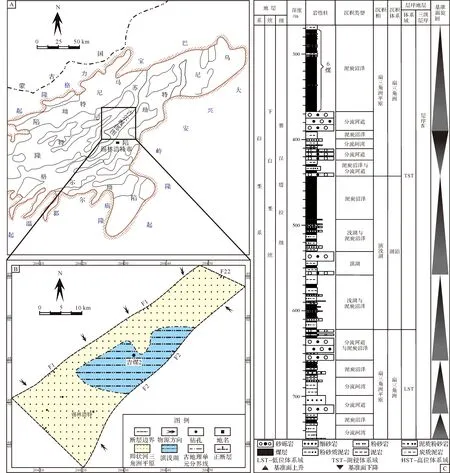
图1 区域地质简图A.研究区域位置图;B.研究区域古地理图;C.沉积相及层序地层柱状图(吉煤2孔)(据文献[19])Fig.1 Geological map of the Jiergalangtu sag of the Erlian BasinA. The location of the study area; B) Paleogeographic map of the study area; C. Comprehensive column of sedimentary facies and sequence stratigraphy of Borehole Jimei 2[19]
2 数据来源与研究方法
将米兰科维奇旋回用于“深时”地层定年研究时,所需前提条件:①地层垂向上要连续,以保证米兰科维奇旋回的连续性;②地层厚度足够大,以保证沉积时限至少涵盖一个完整的偏心率周期[10-23];③地层沉积受轨道气候驱使大于受其他因素影响。因此,本研究选择吉尔嘎郎图凹陷吉煤2钻孔剖面下白垩统赛汉塔拉组连续性好且厚度较大的6号煤层作为研究对象,因该煤层中部有泥岩夹矸分隔,我们将其分为上下两个分层分别进行研究,其深度为305~338.5 m和339.25~369.25 m,视厚度分别为33.5 m和30 m。其中的夹矸为0.75 m厚的泥岩,上分层顶板为碳质泥岩,下分层底板为砂砾岩(图2)。6号煤宏观煤岩类型整体以半亮—半暗型为主,有机物显微组分中镜质组含量为85.47%,惰质组含量10.23%,壳质组含量4.1%,矿物含量8.7%。该煤层的沉积环境为湖泊淤浅而成的泥炭地(图1B)。
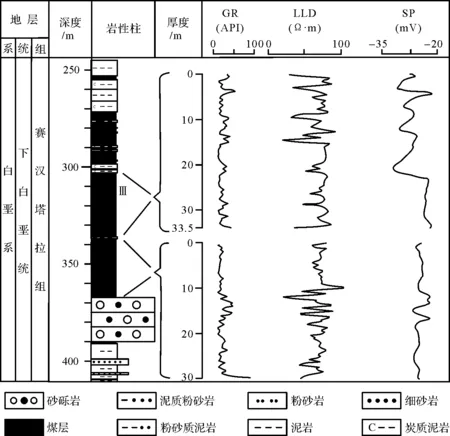
图2 吉尔嘎郎图凹陷早白垩世含煤岩系岩性特征及煤层测井曲线Fig.2 Columinar section showing lithology and geophysical loggings of the coal and coal measures of the Early Cretaceous in Jiergalangtu sag of the Erlian Basin
从工业分析结果来看,6号煤层的灰分含量相对较高(表1),说明成煤泥炭地受地表陆源碎屑物供给影响较大,这类泥炭地一般是受地表水给养的低位泥炭地[24]。假设其他条件(如构造条件)较稳定,则水文条件主要受气候影响,而米兰科维奇旋回作为地质历史时期气候变换的驱动,必然对整个泥炭地发育过程中受水文气候影响的沉积物(如灰分及含盐量)产生了影响[6]。测井数据从不同的角度记录着地质演化历史[25],煤层中自然伽马和三侧向测井信号反映了灰分的含量变化[26];自然电位信号反映了煤层水含盐量的变化[27],因此,本研究选择自然伽马(GR),三侧向测井(LLD)和自然电位(SP)数据来代表煤层灰分含量和煤层水含盐量变化趋势(图2),并以这些变化趋势来探索其中暗含的米兰科维奇旋回周期响应。

表1 吉尔嘎郎图凹陷6号煤层主要煤质指标
注:M.水分;A.灰分;V.挥发分;St.全硫;C.碳含量;ARD.视密度;ad.空气干燥基;d.干燥基;daf.干燥无灰基(可燃基)。
本文采用下面的泥炭地净初级生产力研究方法流程(图3),首先选用合适的测井信息;利用频谱分析得出米兰科维奇旋回周期信息;利用旋回周期长度和周期时间计算出煤层沉积速率和时间;通过煤中碳含量、密度和煤层沉积速率计算出煤中碳的聚集速率;从已有的泥炭地沉积速率预测表中查找与所研究煤层变质程度相近的煤在煤化过程中的碳损,进而计算出泥炭地的碳聚集速率;依据前人总结的泥炭地的碳聚集速率与NPP对比图得出与研究区古纬度带相同区域的碳的聚集速率与NPP的倍数关系,据此计算出早白垩世泥炭地的NPP(图3)。
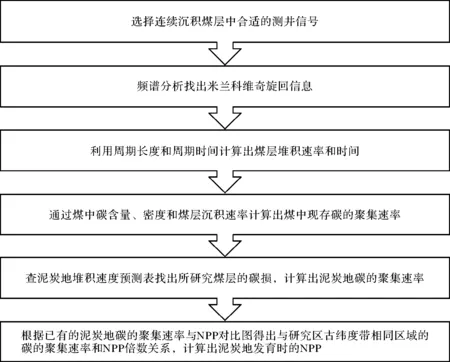
图3 泥炭地生产力分析流程图Fig.3 Flow chart of peatland productivity analysis
复杂的地球物理测井信号用肉眼很难直接识别出其中的稳定的周期旋回,但可以依据傅里叶变换的思想,将复杂的信号转换成不同频率正弦波的叠加,即时频转换,然后通过识别频率反推周期的方式识别出稳定的周期信号[28-29]。根据这一方法,将所有的测井曲线以采样间距为0.125 m进行取值并做频谱分析,上、下两个煤分层的每条测井曲线分别得到269和241个数据点。为提高结果的可信度,对于明显不对称分布的数据(如上段和下段煤层中的GR和LLD数据)先进行取对数(Log10X)处理来增加小数值的权重,从而达到改善数据分布的目的[14]。
借助于SSA-MTM工具箱对处理后的数据进行频谱分析,包括奇异谱分析(SSA)、多窗谱分析(MTM)以及最大熵谱分析(MEM)[30]。SSA 用来确定并移除数据中的低频趋势,并对有意义的频率进行非线性重建;MTM 识别其中包含在米兰科维奇频率范围内的频率并选择置信水平大于(等于)99% 的频谱峰值,如果这些峰值能与MEM 得到的峰值一致则作为有效的显著频率[6]。MTM分析时带数参考值默认取3,分辨率值默认取2,鲁棒背景噪音值使用线性差标准值,MEM分析时将级数参数在n/10至n/3之间改变(n为数据个数),结果未有明显变化。
3 频谱分析结果
区内6号煤两个分层的多条测井曲线频谱分析结果显示有效显著频率分布在低频、中频和高频3组范围内,依次为0.1~0.35,0.54~0.84和0.91~1.29周期/m(图4),平均值分别为0.2、0.7、1.1周期/m,对应的周期长度依次为5 m、1.4 m、0.9 m,周期之比约为5.6∶1.6∶1。该比值与早白垩世(约130 Ma)的米兰科维奇旋回周期比值123 ka(偏心率):38.1 ka(斜率):22.1 ka(岁差)=5.6∶1.7∶1[31-32]相对比,结果比较接近。据此,可以认为该煤层在泥炭地发育时期,其中的灰分和含盐量的沉积变化受到了米兰科维奇旋回的驱动。此外,类似的关于在陆相地层中发现米兰科维奇旋回的事例在中国东北部松辽盆地中已出现多起[33-38],进一步说明本研究结果的合理性。
4 早白垩世泥炭地生产力计算
根据6号煤层频谱分析得出的周期长度5 m,1.4 m,0.9 m和对应的旋回周期123 ka,38.1 ka,22.1 ka,计算出沉积速率范围为0.037~0.041 m/ka,进一步计算出上、下两个煤分层的沉积时限分别是817~905 ka和732~810 ka。由于赛汉塔拉组时代为早白垩世阿普第晚期[39],仅阿普第期时间跨度为13 Ma,远大于煤层聚集时间,因此可以认为本文所得的煤层沉积时限结果是合理的,这也进一步说明煤层中的米兰科维奇旋回周期是合理的。
目前,关于计算成煤泥炭地在发育时期的碳的聚集速率的方法主要有体积压缩法和碳含量推算法。前者通过运用泥炭到成煤过程中的压缩比来反推出泥炭堆积速率,目前,较为公认的泥炭到煤的压缩比范围从30∶1[40]到1.2∶1[41],然后计算出碳聚集速率。依据这一范围计算出的泥炭地的堆积速率为0.04~1.23 m/ka,可以看出,该结果太过宽泛,涵盖了前人统计出的全新世南北纬30°~70°范围内泥炭地堆积速率[42]。另一种方法是依靠煤层中现存碳的含量来计算泥炭地中碳的聚集速率。因为泥炭地中聚集的碳的总量等于煤层中保存下来的碳和泥炭转变为煤过程中损失的碳的总和,与体积压缩无关[43],因此可以先计算出煤中现存碳含量的聚集速率,再考虑损失的碳,进而得出泥炭地中碳的聚集速率。研究区6号煤层的现存碳含量为72.38%(干燥无灰基),视密度为1.31 g/cm3(表1),根据沉积时限817~905 ka和732~810 ka,计算出两段煤层的现存碳的聚集速率都是35.1~38.9 g C/(m2·a),即6号煤层的现存碳的聚集速率是35.1~38.9 g C/(m2·a)。
在泥炭到煤的演化过程即泥炭化作用及煤化作用过程中,原始泥炭中的一部分碳、氢、氧会以CH4和CO2形式散失掉,那么煤层中现存的碳含量要比泥炭地中聚集的原始碳含量少。根据Large等所研究的1万年间泥炭地沉积厚度预测表,现存碳含量为72%,密度为1.3 g/cm3的煤在煤化过程中碳损约为24%[44],计算出6号煤层对应的早白垩世泥炭地的碳聚集速率为46.2~51.2 g C/(m2·a)。
前人已经对全新世的泥炭地碳聚集速率及净初级生产力(NPP)做了大量研究工作。例如,Large等(2007)通过对比两者在全球不同纬度带的数值发现泥炭地碳聚集速率与NPP具有明显正相关性(图5),可以看出,在北纬40°~45°区域的泥炭地的碳聚集速率范围为15~60 g C/(m2·a),均值约为35 g C/(m2·a),NPP范围为150~250 g C/(m2·a),均值约为200 g C/(m2·a),碳聚集速率值和NPP值相差5倍。考虑到本文研究区在早白垩世约位于40°N ~45°N[45],泥炭地碳聚集速率值46.2~51.2 g C/(m2·a),将5倍数值关系应用到本研究区,计算出对应的NPP值应为231~256 g C/(m2·a)。
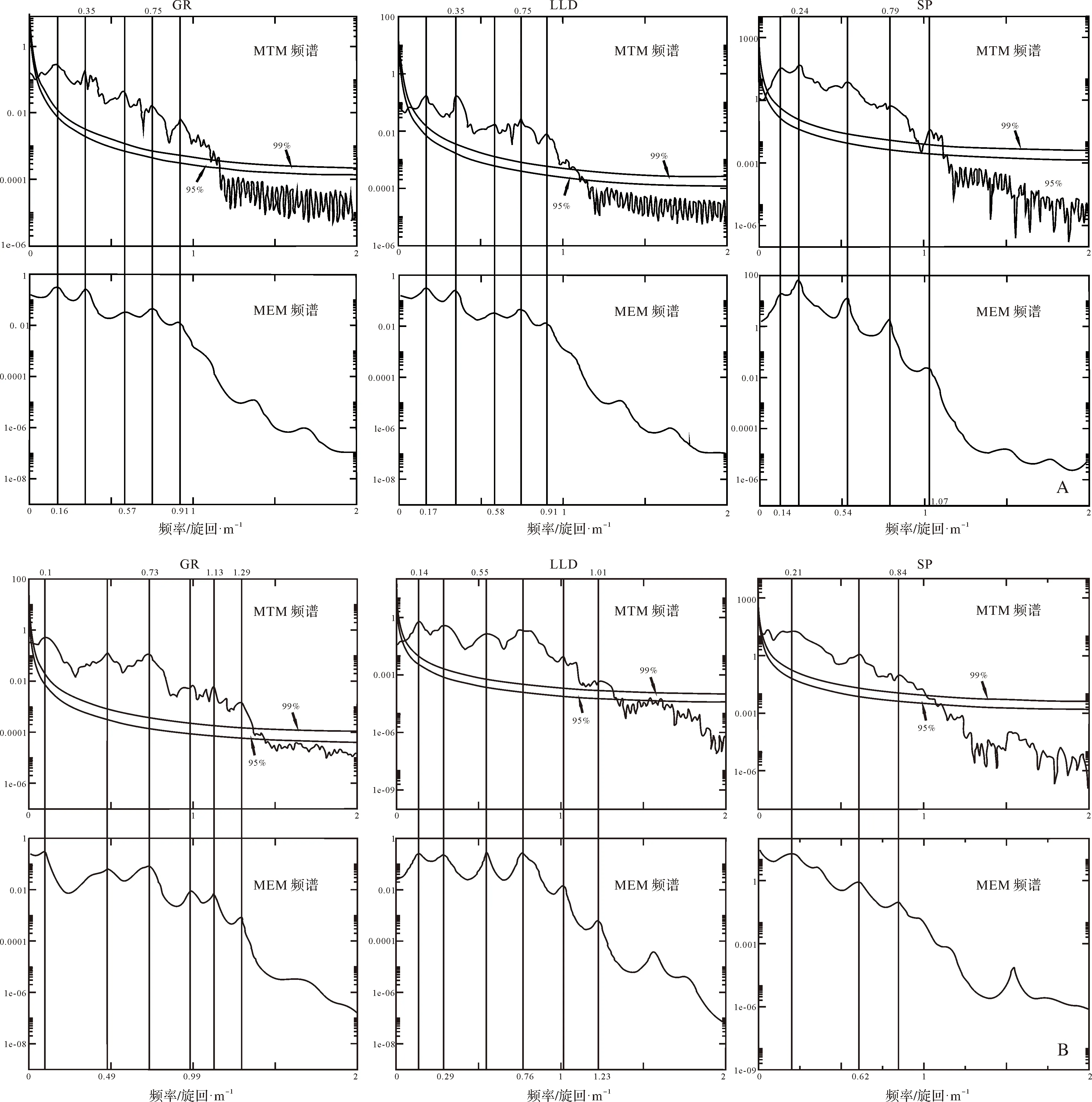
图4 二连盆地吉尔嘎郎图凹陷6号煤层频谱分析结果A. 6号煤层上分层;B. 6号煤层下分层Fig.4 Spectrum analysis results of the No. 6 coal in Jiergalangtu sag of the Erlian Basin A. upper segment of the No. 6 coal; B. lower segment of the No. 6 coal
5 早白垩世泥炭地生产力水平、影响因素及研究意义
与前人研究的全新世40°N~45°N泥炭地碳聚集速率值和NPP值(图5)比较可以看出,本次计算结果在其数值范围内,但明显偏高。关于研究区早白垩世泥炭地生产力水平相对于全新世较高的原因,下面将从温度、沼泽养分、古火灾事件以及大气中CO2和O2含量方面来分析。
全新世处于间冰期,整体温度与现代相接近[47],白垩纪处于石炭纪冰期与第四纪冰期之间的温室期中[48],温暖期温度明显高于现代,寒冷期温度与第四纪相近[49],对比两个时代的同一纬度带区域温度,很可能早白垩世的温度要比全新世温度高很多,从而使得早白垩世该纬度带内的泥炭地更适合植物生长,生产力水平提高较明显。
研究区泥炭地发育于滨湖地区(图1B),为地表水给养的低位沼泽,水分和养分充足[24],植物生长茂盛,全新世该纬度带研究区同样多为水源补给充裕的低位泥炭沼泽[44],因此,沼泽养分很可能不是导致早白垩世研究区泥炭地生产力较全新世研究区泥炭地生产力有所提升的原因。
研究煤层中惰质组含量仅为10.23%,且当时的氧气含量约为21%(图6),前人的燃烧实验显示,与地质记录兼容的、能够支持燃烧的大气氧含量范围为15%~35%[50],21%相对较低,说明早白垩世泥炭地净初级生产力受火灾事件影响很小。
CO2和O2分别促进了植物的光合作用和呼吸作用,其含量的不同也会导致植物的净初级生产力不同。植物光合作用固定的碳均来自空气中CO2[51],因此,其浓度的高低会直接影响植物的净初级生产力高低;另有数值模拟研究显示,在不考虑气候与CO2含量变化时,O2含量升高11%时,陆相生物圈的净初级生产力降低10%[46]。本研究中赛汉塔拉组煤层对应的泥炭地发育时期O2和CO2模拟含量分别约为21%和0.15%(图6),O2含量和全新世几乎相同,相对于全新世约0.03%的CO2含量[52],本研究中早白垩世CO2含量高出4倍。因此,在不考虑其他因素影响时,相对较高浓度的CO2含量很可能为早白垩世泥炭地净初级生产力带来较高的肥效作用,使得计算结果明显位于高值区。
以上分析表明,早白垩世泥炭地生产力水平是温度、大气中氧气和二氧化碳含量叠加控制的结果,但其中对泥炭地生产力具有重要影响作用的是温度和二氧化碳含量。同样地,邵龙义等在对中国西南地区晚二叠世泥炭地生产力水平进行研究之后,也认为大气中二氧化碳含量对泥炭地生态系统生产力具有重要影响[6],进一步说明了大气中二氧化碳含量对于控制泥炭地生产力水平具有关键作用。又因为大气中二氧化碳含量及温度与气候密切相关,因此,可以设想通过对不同地区、时代形成的泥炭地生产力水平进行研究反推当时的古气候状况。
然而,为实现这一设想,需要先依据目前已建立的大气中二氧化碳变化模型及前人已认知的古气候温度对泥炭地生产力水平与二氧化碳含量之间的密切关联进行充分的验证,然后再对多地区、多时代形成的泥炭地生产力水平进行研究反推当时的古气候状况。
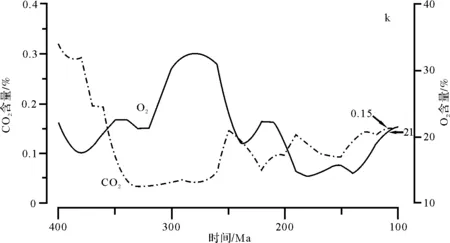
图6 地质历史时期大气中的氧含量(Berner[53])和二氧化碳含量(Berner[54])的变化阴影部分K表示本研究中煤层对应泥炭地发育时期位置[31]Fig.6 Variation of atmospheric O2 levels (Berner[53]) and CO2 contents (Berner[54]) through geological time(K in the shaded area represents the Cretaceous[31])
6 结论
(1) 通过对内蒙古二连盆地吉尔嘎郎图凹陷早白垩世6号煤层地球物理测井信号进行频谱分析发现,该煤层中发育周期为123 ka(偏心率):38.1 ka(斜率)∶22.1 ka(岁差)的米兰科维奇旋回,厚度为33.5 m和30 m的煤层堆积时限分别为817~905 ka和732~810 ka。
(2) 将识别出的米兰科维奇旋回周期作为时间度量尺度,计算出的早白垩世煤中现存碳的聚集速率为35.1~38.9 g C/(m2·a),对应泥炭地碳的聚集速率为46.2~51.2 g C/(m2·a),NPP为231~256 g C/(m2·a)。
(3) 将计算结果与全新世同一纬度带泥炭地生产力比较分析,认为泥炭地生产力水平主要受温度和大气中二氧化碳含量控制,又因这两种因素与当时的古气候相关联,因此泥炭地生产力研究可能对进一步了解“深时”古气候有帮助。
References)
1 Greb S F, DiMichele W A, Gastaldo R A. Evolution and importance of wetlands in earth history[M]//Greb S F, DiMichele W A. Wetlands Through Time. Geological Society of America Special Publication, 2006, 399: 1-40.
2 Gorham E. Northern peatlands: role in the carbon cycle and probable responses to climatic warming[J]. Ecological Applications, 1991, 1(2): 182-195.
3 Charman D. Peatlands and Environmental Change[M]. Chichester: Wiley, 2002: 1-312.
4 Large D J. A 1.16 Ma record of carbon accumulation in western European peatland during the Oligocene from the Ballymoney lignite, Northern Ireland[J]. Journal of the Geological Society, 2007, 164(6): 1233-1240.
5 邵龙义,鲁静,汪浩,等. 中国含煤岩系层序地层学研究进展[J]. 沉积学报,2009,27(5):904-914. [Shao Longyi, Lu Jing, Wang Hao, et al. Developments of coal measures sequence stratigraphy in China[J]. Acta Sedimentologica Sinica, 2009, 27(5): 904-914.]
6 邵龙义,汪浩,Large D J. 中国西南地区晚二叠世泥炭地净初级生产力及其控制因素[J]. 古地理学报,2011,13(5):473-480. [Shao Longyi, Wang Hao, Large D J. Net primary productivity and its control of the Late Permian peatlands in southwestern China[J]. Journal of Palaeogeography, 2011, 13(5): 473-480.]
7 Allègre C J. Isotope Geology[M]. Cambridge: Cambridge University Press, 2008: 1-512.
8 Wu Huaichun, Zhang Shihong, Hinnov L A, et al. Time-calibrated Milankovitch cycles for the late Permian[J]. Nature Communications, 2013, 4: 2452.
9 李江涛,余继峰,李增学. 基于测井数据小波变换的层序划分[J]. 煤田地质与勘探,2004,32(2):48-50. [Li Jiangtao, Yu Jifeng, Li Zengxue. The demarcating of stratigraphic sequence based on wavelet transform of well-logging data[J]. Coal Geology & Exploration, 2004, 32(2): 48-50.]
10 Schwarzacher W. Cyclostratigraphy and the Milankovitch Theory[M]. Amsterdam: Elsevier, 1993: 1-225.
11 张运波,王根厚,余正伟,等. 四川盆地中二叠统茅口组米兰科维奇旋回及高频层序[J]. 古地理学报,2013,15(6):777-786. [Zhang Yunbo, Wang Genhou, Yu Zhengwei, et al. Milankovitch cycles and high-frequency sequences of the Middle Permian Maokou Formation in Sichuan Basin[J]. Journal of Palaeogeography, 2013, 15(6): 777-786.]
12 孙阳,樊太亮,傅良同,等. 大庆长垣姚家组高频层序地层与米兰科维奇旋回对应性[J]. 现代地质,2011,25(6):1145-1151,1166. [Sun Yang, Fan Tailiang, Fu Liangtong, et al. Correspondence between high frequency sequences and Milankovitch cycles of Yaojia Formation in Daqing Placanticline[J]. Geoscience, 2011, 25(6): 1145-1151, 1166.]
13 Large D J, Jones T F, Briggs J, et al. Orbital tuning and correlation of 1.7 m.y. of continuous carbon storage in an early Miocene peatland[J]. Geology, 2004, 32(10): 873-876.
14 Large D J, Jones T F, Somerfield C, et al. High-resolution terrestrial record of orbital climate forcing in coal[J]. Geology, 2003, 31(4): 303-306.
15 吴怀春,张世红,冯庆来,等. 旋回地层学理论基础、研究进展和展望[J]. 地球科学,2011,36(3):409-428. [Wu Huaichun, Zhang Shihong, Feng Qinglai, et al. Theoretical basis, research advancement and prospects of cyclostratigraphy[J]. Earth Science, 2011, 36(3): 409-428.]
16 陈代钊. 旋回地层学—一个正在发展中的理论[J]. 第四纪研究,2000,20(2):186-195. [Chen Daizhao. Cyclostratigraphy: a developing theory[J]. Quaternary Sciences, 2000, 20(2): 186-195.]
17 孙枢,王成善. “深时”(Deep time)研究与沉积学[J]. 沉积学报,2009,27(5):792-810. [Sun Shu, Wang Chengshan. Deep time and sedimentology[J]. Acta Sedimentologica Sinica, 2009, 27(5): 792-810.]
18 祝玉衡,张文朝. 二连盆地下白垩统沉积相及含油性[M]. 北京:科学出版社,2000:1-234. [Zhu Yuheng, Zhang Wenchao. Sedimentary Facies and Oil Bearing Properties of Lower Cretaceous in Erlian Basin[M]. Beijing: Science Press, 2000: 1-234.]
19 王帅,邵龙义,闫志明,等. 二连盆地吉尔嘎朗图凹陷下白垩统赛汉塔拉组层序地层及聚煤特征[J]. 古地理学报,2015,17(3):393-403. [Wang Shuai, Shao Longyi, Yan Zhiming, et al. Sequence stratigraphy and coal accumulation of the Lower Cretaceous Saihantala Formation in Jiergalangtu sag of Erlian Basin[J]. Journal of Palaeogeography, 2015, 17(3): 393-403.]
20 王东东,邵龙义,张强,等. 二连盆地群下白垩统含煤地层聚煤特征分析[J]. 中国矿业大学学报,2013,42(3):257-265. [Wang Dongdong, Shao Longyi, Zhang Qiang, et al. Analysis of coal-accumulating characteristics in the Lower Cretaceous coal-containing strata of the Erlian Basin group[J]. Journal of China University of Mining & Technology, 2013, 42(3): 257-265.]
21 金明,李妩巍. 乌兰花地区下白垩统、上新统岩石地球化学特征及其古气候演变[J]. 铀矿地质,2003,19(6):349-354. [Jin Ming, Li Wuwei. Petrogeochemical characteristics of Lower Cretaceous and Pliocene rocks and paleoclimate evolution in Wulanhua region[J]. Uranium Geology, 2003, 19(6): 349-354.]
22 Boulila S, Galbrun B, Hinnov L A, et al. Milankovitch and sub-Milankovitch forcing of the Oxfordian (Late Jurassic) Terres Noires Formation (SE France) and global implications. Basin Research, 2010, 22(5): 717-732.
23 Weedon G P. Time-Series Analysis and Cyclostratigraphy: Examining Stratigraphic Records of Environmental Cycles[M]. New York: Cambridge University Press, 2003: 1-274.
24 Moore P D. Ecological and hydrological aspects of peat formation[M]//Scott A C. Coal and Coal-bearing Strata: Recent Advances. Geological Society, London, Special Publications, 1987, 32: 7-15.
25 余继峰,李增学. 测井数据小波变换及其地质意义[J]. 中国矿业大学学报,2003,32(3):336-339. [Yu Jifeng, Li Zengxue. Wavelet transform of logging data and its geological significance[J]. Journal of China University of Mining & Technology, 2003, 32(3): 336-339.]
26 Diessel C F K. Coal-bearing Depositional Systems[M]. New York: Springer-Verlag, 1992: 1-721.
27 宋子齐,景成,孙宝佃,等. 自然电位、自然伽马测井曲线在文15块的应用[J]. 断块油气田,2011,18(1):130-133. [Song Ziqi, Jing Cheng, Sun Baodian, et al. Application of self-potential and gamma ray logging curves in Block Wen 15[J]. Fault-Block Oil & Gas Field, 2011, 18(1): 130-133.]
28 邵龙义,何志平,鲁静. 环渤海湾西部石炭系—二叠系层序地层及聚煤作用研究[M]. 北京:地质出版社,2008:111. [Shao Longyi, He Zhiping, Lu Jing. Carboniferous-Permian Sequence Stratigraphy and Coal Accumulation in the West of Bohai Bay[M]. Beijing: Geological Publishing House, 2008: 111.]
29 付文钊,余继峰,杨锋杰,等. 测井记录中米氏旋回信息提取及其沉积学意义——以济阳坳陷区为例[J]. 中国矿业大学学报,2013,42(6):1025-1032. [Fu Wenzhao, Yu Jifeng, Yang Fengjie, et al. Feature extraction of Milankovitch cycle in well logs and its sedimentological significance: A case study of Jiyang depression zone[J]. Journal of China University of Mining & Technology, 2013, 42(6): 1025-1032.]
30 Ghil M, Allen M R, Dettinger M D, et al. Advanced spectral methods for climatic time series[J]. Reviews of Geophysics, 2002, 40(1): 3-1-3-41.
31 Berger A, Loutre M F, Dehant V. Pre-Quaternary Milankovitch frequencies[J]. Nature, 1989, 342(6246): 133.
32 Berger A, Loutre M F, Laskar J. Stability of the astronomical frequencies over the earth's history for paleoclimate studies[J]. Science, 1992, 255(5044): 560-566.
33 程日辉,王国栋,王璞珺. 松辽盆地白垩系泉三段—嫩二段沉积旋回与米兰科维奇周期[J]. 地质学报,2008,82(1):55-64. [Cheng Rihui, Wang Guodong, Wang Pujun. Sedimentary cycles of the Cretaceous Quantou—Nenjiang Formations and Milankovitch cycles of the South Hole of the SLCORE-Ⅰin the Songliao Basin[J]. Acta Geologica Sinica, 2008, 82(1): 55-64.]
34 程日辉,王国栋,王璞珺,等. 松科1井南孔白垩系姚家组沉积序列精细描述:岩石地层、沉积相与旋回地层[J]. 地学前缘,2009,16(2):272-287. [Cheng Rihui, Wang Guodong, Wang Pujun, et al. Description of Cretaceous sedimentary sequence of the Yaojia Formation recovered by CCSD-SK-Ⅰs borehole in Songliao Basin: lithostratigraphy, sedimentary facies and cyclic stratigraphy[J]. Earth Science Frontiers, 2009, 16(2): 272-287.]
35 高有峰,王璞珺,程日辉,等. 松科1井南孔白垩系青山口组一段沉积序列精细描述:岩石地层、沉积相与旋回地层[J]. 地学前缘,2009,16(2):314-323. [Gao Youfeng, Wang Pujun, Cheng Rihui, et al. Description of Cretaceous sedimentary sequence of the first member of the Qingshankou Formation recovered by CCSD-SK-Ⅰs borehole in Songliao Basin: lithostratigraphy, sedimentary facies and cyclic stratigraphy[J]. Earth Science Frontiers, 2009, 16(2): 314-323.]
36 王国栋,程日辉,王璞珺,等. 松科1井南孔白垩系泉头组沉积序列精细描述:岩石地层、沉积相与旋回地层[J]. 地学前缘,2009,16(2):324-338. [Wang Guodong, Cheng Rihui, Wang Pujun, et al. Description of Cretaceous sedimentary sequence of the Quantou Formation recovered by CCSD-SK-Ⅰs borehole in Songliao Basin: lithostratigraphy, sedimentary facies and cyclic stratigraphy[J]. Earth Science Frontiers, 2009, 16(2): 324-338.]
37 吴怀春,张世红,黄清华. 中国东北松辽盆地晚白垩世青山口组浮动天文年代标尺的建立[J]. 地学前缘,2008,15(4):159-169. [Wu Huaichun, Zhang Shihong, Huang Qinghua. Establishment of floating astronomical time scale for the terrestrial Late Cretaceous Qingshankou Formation in the Songliao Basin of Northeast China[J]. Earth Science Frontiers, 2008, 15(4): 159-169.]
38 Wu Huaichun, Zhang Shihong, Jiang Ganqing, et al. The floating astronomical time scale for the terrestrial Late Cretaceous Qingshankou Formation from the Songliao Basin of Northeast China and its stratigraphic and paleoclimate implications[J]. Earth and Planetary Science Letters, 2009, 278(3/4): 308-323.
39 杨静,王志萍,王伟栋. 二连盆地西部赛汉塔拉组轮藻化石及其时代意义[J]. 大庆石油地质与开发,2003,22(3):19-21. [Yang Jing, Wang Zhiping, Wang Weidong. Charophyte fossils from the Saihantala Formation in western Erlian Basin[J]. Petroleum Geology & Oilfield Development in Daqing, 2003, 22(3): 19-21.]
40 Zaritsky R V. On thickness decrease of parent substance of coal[C]//Proceedings of the 7th International Congress on Carboniferous Stratigraphy and Geology, Comptes Rendus, 4: Frefeld. Westfalen: Geologisches Landesamt Nordrhein, 1975: 393-396.
41 Nadon G C. Magnitude and timing of peat-to-coal compaction[J]. Geology, 1998, 26(8): 727-730.
42 Diessel C, Boyd R, Wadsworth J, et al. On balanced and unbalanced accommodation/peat accumulation ratios in the Cretaceous coals from Gates Formation, Western Canada, and their sequence-stratigraphic significance[J]. International Journal of Coal Geology, 2000, 43(1/2/3/4): 143-186.
43 Clymo R S, Turunen J, Tolonen K. Carbon accumulation in peatland[J]. Oikos, 1998, 81(2): 368-388.
44 Large D J, Chris M. Use of carbon accumulation rates to estimate the duration of coal seams and the influence of atmospheric dust deposition on coal composition[J]. Geological Society, London, Special Publications, 2015, 404(1): 303-315.
45 洪汉净,马宗晋,程国梁,等. 我国大陆古板块运动演化的特征[J]. 石油与天然气地质,2005,26(1):23-28. [Hong Hanjing, Ma Zongjin, Cheng Guoliang. et al. Characteristics of fossil continental plate evolution and movement in China[J]. Oil & Gas Geology, 2005, 26(1): 23-28.]
46 Beerling D J, Woodward F I. Vegetation and the Terrestrial Carbon Cycle: Modelling the First 400 Million Years[M]. Cambridge: Cambridge University Press, 2001: 1-405.
47 王绍武. 全新世气候[J]. 气候变化研究进展,2009,5(4):247-248. [Wang Shaowu. Holocene climate[J]. Advances in Climate Change Research, 2009, 5(4): 247-248.]
48 Huber B T, Norris R D, Macleod K G. Deep-sea paleotemperature record of extreme warmth during the Cretaceous[J]. Geology, 2002, 30(2): 123-126.
49 Hay W W, Floegel S. New thoughts about the Cretaceous climate and oceans[J]. Earth-Science Reviews, 2012, 115(4): 262-272.
50 Scott A C, Glasspool I J. The diversification of Paleozoic fire systems and fluctuations in atmospheric oxygen concentration[J]. Proceedings of the National Academy of Sciences of the United States of America, 2006, 103(29): 10861-10865.
51 叶子飘. 光合作用对光和CO2响应模型的研究进展[J]. 植物生态学报,2010,34(6):727-740. [Ye Zipiao. A review on modeling of responses of photosynthesis to light and CO2[J]. Chinese Journal of Plant Ecology, 2010, 34(6): 727-740.]
52 Petit J R, Jouzel J, Raynaud D, et al. Climate and atmospheric history of the past 420000 years from the Vostok ice core, Antarctica[J]. Nature, 1999, 399(6735): 429-436.
53 Berner R A. Phanerozoic atmospheric oxygen: new results using the GEOCARBSULF model[J]. American Journal of Science, 2009, 309(7): 603-606.
54 Berner R A. GEOCARBSULF: a combined model for Phanerozoic atmospheric O2and CO2[J]. Geochimica et Cosmochimica Acta, 2006, 70(23): 5653-5664.
Net Primary Productivity and Its Control Factors of Early Cretaceous Peatlands: Evidence from No.6 Coal in the Jiegalangtu sag of the Erlian Basin
YAN ZhiMing1SHAO LongYi1WANG Shuai1Large D J2WANG Hao1SUN QinPing3
(1. College of Geoscience and Surveying Engineering , China University of Mining and Technology ( Beijing), Beijing 100083, China; 2. Faculty of Engineering, University of Nottingham, UK, NG7 2RD; 3. PetroChina Research Institute of Petroleum Exploration & Development-Langfang Branch, Langfang, Hebei 065007, China)
Peatlands contain a huge amount of carbon whose productivity will affect the global carbon cycle and even climate change. A number of productivity researches have been done on the Holocene peats, but few is dealing with the pre-quaternary due to a lack of precise dating method. In this paper, the geophysical logging signals were used to analyze the Milankovitch orbital cycles which were further used as a tool to date the “deep time” and to measure the carbon accumulation rates of the paleo-peatlands. The spectrum analysis has been conducted on the geophysical logging signals of a thick coal (No.6 seam) of the Early Cretaceous in the Jiergalangtu sag of the Erlian Basin, and the Milankovitch cycle parameters of 123 ka (eccentricity) : 38.1 ka (slope) : 22.1 ka (precession) have been obtained for this coal. These Milankovitch cycles were used as “measurement” to calculate the carbon accumulation rate and the net primary productivity (NPP) based on the carbon contents and coal rank of coal. The No.6 coal had a carbon accumulation rate of 35.1~38.9 g C/(m2·a) which corresponds to the carbon accumulation rate of 46.2~51.2 g C/(m2·a) and the net primary productivity (NPP) of 231~256 g C/(m2·a) for the Early Cretaceous peatlands. A comprehensive comparison with the productivity levels of the Holocene peatlands (NPP) of 150~250 g C /(m2·a) in the same latitude confirmed that the productivity level in the Early Cretaceous peatlands were controlled by paleo-temperature and concentration of carbon dioxide in the atmosphere. As the paleotemperature and concentration of carbon dioxide were closely related to the paleoclimates, these productivity values of the paleo-peatland would help us understand more about paleoclimates of “deep time”.
peatland; Milankovitch cycle; carbon accumulation rate; net primary productivity (NPP); deep time; Early Cretaceous
1000-0550(2016)06-1068-09
10.14027/j.cnki.cjxb.2016.06.006
2016-03-14; 收修改稿日期: 2016-05-23
国家自然科学基金重点项目(41572090);国家科技重大专项(2016ZX05041004-003)[Foundation:Key Project of National Nature Science Foundation of China, No. 41572090; National Key Science and Technology Project, No. 2016ZX05041004-003]
闫志明 男 1990年出生 博士研究生 煤田地质学和层序地层学 E-mail: 940857663@qq.com
简介 邵龙义 男 教授 E-mail: shaol@cumtb.edu.cn
P618.117
A
